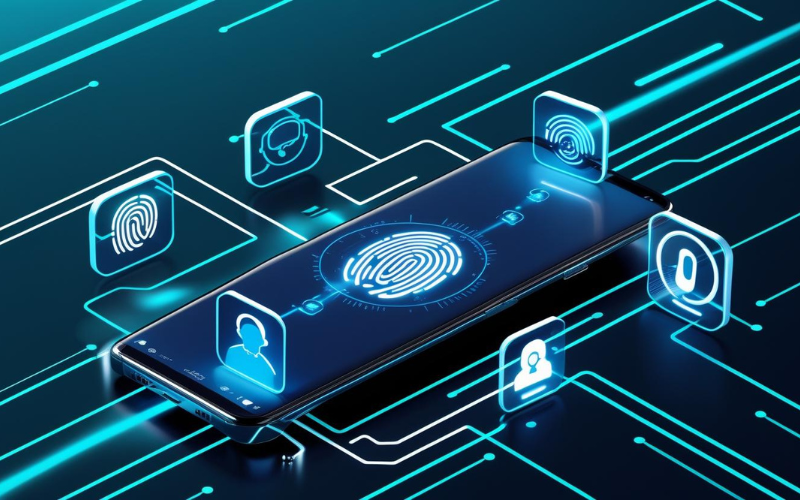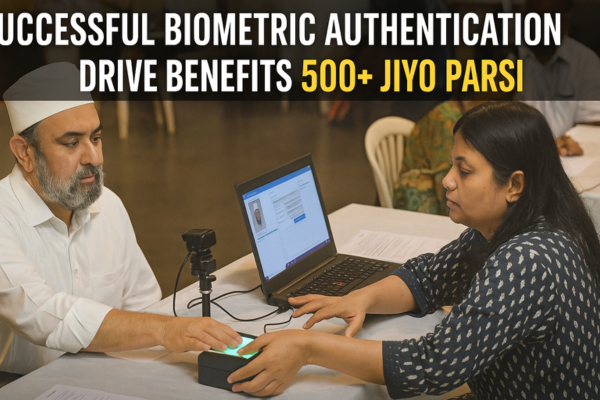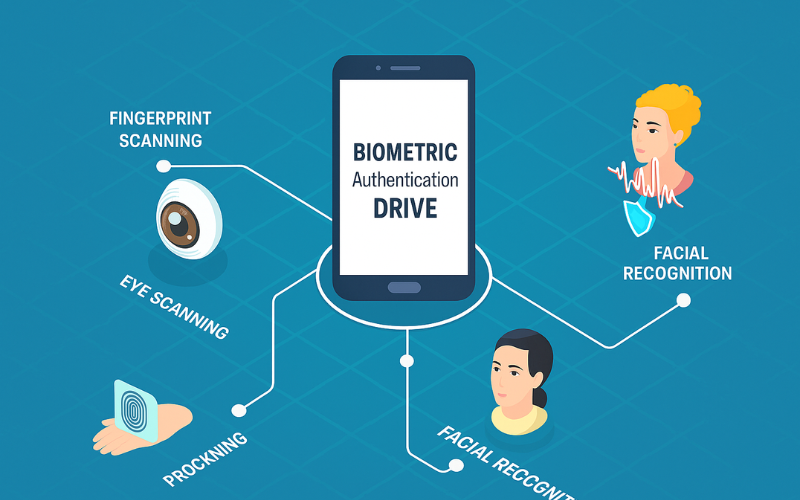Mumbai Hosts Biometric Authentication Drive for Jiyo Parsi Beneficiaries by Minority Affairs Ministry
The Ministry of Minority Affairs recently spearheaded a major Biometric Authentication Drive in Mumbai, targeting beneficiaries of the Jiyo Parsi scheme. This innovative initiative underscores the government’s steadfast commitment to empowering India’s minority communities and ensuring accurate identification of beneficiaries. The event, a significant milestone in streamlining welfare initiatives, successfully brought together numerous stakeholders, including Jiyo Parsi beneficiaries, program coordinators, and government officials. Through the adoption of biometric technology, the Biometric Authentication Drive not only ensured transparency but also reinforced the integrity of welfare distribution mechanisms.
The Importance of Biometric Authentication in Welfare Initiatives
Biometric authentication has emerged as a game-changer in welfare delivery systems. By relying on unique physical identifiers such as fingerprints, iris scans, and facial recognition, biometric systems minimize errors and eliminate the possibility of duplication or fraud. The Biometric Authentication Drive in Mumbai exemplifies how modern technology can enhance the effectiveness and credibility of government programs.
The Ministry’s adoption of biometric verification reflects a forward-thinking approach to governance. This technological leap ensures that government resources reach the intended beneficiaries, preventing any misuse. In the case of the Jiyo Parsi scheme, this effort safeguards the initiative’s goals of supporting the Parsi community and fostering demographic revival.
Mumbai: The Ideal Host for the Drive
Mumbai, often regarded as the heart of the Parsi community in India, was a fitting choice for the Biometric Authentication Drive. The city’s deep historical and cultural ties with the Parsi population make it an ideal location for implementing community-centric initiatives.
With a large turnout, the Biometric Authentication Drive witnessed participation from over 500 beneficiaries, including families, senior citizens, and young professionals. The event was conducted at a centrally located and well-equipped venue, ensuring accessibility for all attendees. Beneficiaries traveled from across the city and nearby regions, underscoring the importance of the initiative to the community.
Jiyo Parsi Scheme: A Lifeline for the Community
The Jiyo Parsi scheme, introduced in 2013, is a pioneering initiative by the Ministry of Minority Affairs aimed at addressing the declining population of the Parsi community in India. The program offers financial assistance for medical procedures such as in-vitro fertilization (IVF), marriage counseling, and advocacy campaigns that encourage family growth within the community.
The Biometric Authentication Drive plays an integral role in the scheme’s success by verifying the eligibility of beneficiaries. This meticulous process ensures that the program’s resources are directed toward deserving individuals, reinforcing trust within the community and enhancing the scheme’s overall impact.
Streamlining Verification Through Technology
The Biometric Authentication Drive in Mumbai demonstrated the Ministry’s dedication to leveraging technology for public welfare. The event was executed with precision, ensuring a seamless experience for participants. Beneficiaries were required to present valid identification documents, after which their biometric data—including fingerprints and iris scans—was captured and matched against the program’s database.
Officials emphasized the importance of biometric authentication in building a robust and error-free digital framework. Each phase of the verification process was carefully monitored to maintain accuracy and efficiency, highlighting the Ministry’s commitment to excellence.
Participant Experience and Feedback
The success of the Biometric Authentication Drive was reflected in the positive feedback from beneficiaries. Many participants expressed gratitude for the government’s efforts to modernize welfare delivery systems.
“The biometric process was straightforward and well-organized,” remarked one beneficiary. “It’s reassuring to see such advanced measures being taken for the welfare of our community.”
Elderly participants, who initially faced challenges with the technology, were assisted by trained personnel, ensuring that no one was left behind. The support extended by volunteers and officials was widely appreciated, further bolstering the initiative’s success.
Challenges and Adaptations
While the Biometric Authentication Drive was largely successful, it wasn’t without its challenges. Some participants, particularly the elderly, found it difficult to adapt to the technology. However, the Ministry’s deployment of trained personnel and volunteers ensured that these hurdles were swiftly addressed.
Another notable challenge was the logistical effort required to coordinate such a large-scale event. From ensuring adequate technical infrastructure to managing a high volume of participants, the drive demanded meticulous planning and execution. Despite these challenges, the Biometric Authentication Drive was a resounding success, setting a precedent for future drives.
Expanding the Initiative Nationwide
The success of the Biometric Authentication Drive in Mumbai has paved the way for similar initiatives in other cities. The Ministry of Minority Affairs has announced plans to extend the program to other regions with significant Parsi populations. By doing so, the government aims to ensure that all beneficiaries of the Jiyo Parsi scheme are accurately verified, fostering greater transparency and inclusivity.

This expansion will also provide valuable insights into the challenges and opportunities associated with implementing biometric systems on a broader scale. Lessons learned from the Biometric Authentication Drive in Mumbai will inform the design and execution of future initiatives, ensuring continuous improvement.
In-Depth Look at the Biometric Process
The process adopted during the Biometric Authentication Drive was both efficient and user-friendly. It began with a systematic registration phase, where participants’ personal details were cross-verified with official records. Following registration, biometric data including fingerprints, iris scans, and photographs were collected.
Advanced biometric devices were employed to ensure the accuracy and security of the data. Each entry was instantly cross-checked with the existing database, allowing for real-time verification. This not only sped up the process but also reduced the chances of discrepancies.
Trained personnel were stationed throughout the venue to assist participants, especially those unfamiliar with the technology. Clear instructions and step-by-step guidance were provided, ensuring a smooth experience for everyone involved.
Historical Context of Biometric Technology in Welfare
The use of biometric technology in welfare schemes is not new. Governments across the world have adopted similar measures to ensure that aid reaches the deserving. India, with its large and diverse population, has been a frontrunner in integrating biometric systems, starting with the Aadhaar program.
The Aadhaar initiative, launched in 2009, aimed to provide a unique identification number to every citizen. Over the years, it has become a cornerstone for welfare delivery, including subsidy distribution, pension disbursements, and now, initiatives like the Biometric Authentication Drive and the Jiyo Parsi scheme. The success of Aadhaar has laid the groundwork for drives like the one in Mumbai, proving the efficacy of biometric technology in governance.
Community Impact of the Drive
The Biometric Authentication Drive has had a profound impact on the Parsi community in Mumbai. By reinforcing the credibility of the Jiyo Parsi scheme, the drive has instilled a renewed sense of trust and confidence among beneficiaries.
For many participants, the Biometric Authentication Drive also served as a platform for community interaction. Families and individuals who rarely had the opportunity to engage with government initiatives were able to voice their opinions and concerns directly to officials. This two-way communication not only enhanced the event’s effectiveness but also strengthened the bond between the community and the government.
Building a Transparent Welfare System
One of the most significant outcomes of the Biometric Authentication Drive is the establishment of a transparent welfare distribution system. By eliminating manual errors and potential fraud, biometric authentication ensures that resources are allocated to the right individuals.
The success of this initiative has set a benchmark for other welfare programs across the country. By integrating advanced technology with community-centric governance, the Ministry of Minority Affairs has demonstrated how innovation can drive social progress.
Widening the Reach: A Vision for the Future
As the success of the Mumbai initiative resonates across the nation, the Ministry has ambitious plans to integrate biometric technology into other minority welfare schemes. Building on the strong foundation laid by the Biometric Authentication Drive, future programs will incorporate lessons learned and innovate further to address emerging challenges. From integrating multi-lingual biometric kiosks for better accessibility to enhancing data security measures, the road ahead is filled with potential.
Moreover, the Ministry envisions partnering with community organizations to better address the needs of beneficiaries, ensuring not only the efficiency of the system but also its inclusivity. By fostering collaboration between government and society, the true impact of welfare schemes can be realized, creating a framework that others may follow.
Leveraging Global Practices
Across the globe, countries like Estonia, Germany, and South Korea have successfully implemented biometric systems for public services. By examining these examples, India can adapt best practices and avoid pitfalls. Estonia’s e-residency program and Germany’s biometric passports demonstrate how efficient and secure systems can enhance public trust and accessibility. Lessons from these nations could inspire further innovation in India’s welfare ecosystem.
Conclusion
The Biometric Authentication Drive conducted in Mumbai represents a significant milestone in the government’s efforts to empower minority communities through technology-driven solutions. By ensuring transparency, accuracy, and inclusivity, this initiative underscores the Ministry’s commitment to fostering trust and accountability in welfare programs.
As the government continues to expand this initiative, the Parsi community and other minority groups can look forward to a brighter and more secure future. The success of the Biometric Authentication Drive serves as a testament to the power of innovation and collaboration in achieving societal progress.
Through this initiative, the Ministry of Minority Affairs has not only strengthened the Jiyo Parsi scheme but also set a gold standard for implementing technology in governance. It marks the beginning of a transformative journey, promising better days for minority communities across India.


